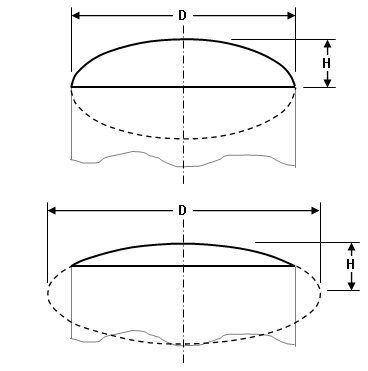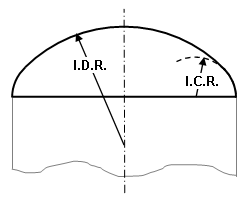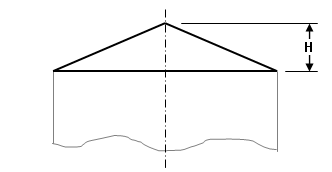Activating the command:
|
Model |
for single nozzle vessels |
|
Multiple nozzles |
for heads on cylinder (multiple nozzle vessels) |
|
Multiple nozzles |
for heads on nozzle (multiple nozzle vessels) |
There are multiple types of heads that can be added to either end of the cylinder or to the end of a nozzle. This is selected in the Type of head drop-down box. See Figure 1.
- If the Flat option is selected, a flat plate will be created at the end.
- If the Spherical option is selected, you must specify a value in the Diameter field. A hemispherical head is created if the diameter equals the diameter of the cylinder or nozzle. Otherwise, a sector of a sphere is created.
- If the Ellipsoidal option is selected, you can define the dimensions of the heads using three options available in the Input type for ellipsoidal head uses drop-down box.
- If the Direct input of diameter and height option is selected, you must specify these parameters in the Diameter and Height fields. If the diameter of the head is greater than the diameter of the cylinder, the connection will have a sharp bend. If the two diameters are equal, the connection will be flush.
- If the Rotation angle option is selected, you must specify values in the Diameter and Rotation Angle fields. This option will use a projection of a circle of the specified diameter, which has been rotated about an axis perpendicular to the length of the cylinder. A value of 0 will result in a spherical head. A value of 90 will result in a flat head.
- If the Ellipsoidal ratio option is selected, you must specify a value in the Ellipse Ratio field. This value is the ratio of the radius to the height of the head where the radius is half of the cylinder diameter. This option will always create a smooth connection between the cylinder and head.
- If the Torispherical option is selected, you must specify values in the Spherical radius (I.D.R.) and Knuckle radius (I.C.R.) fields. The torispherical geometry is formed from two curves. The spherical radius is the larger of these two curves and is used toward the center of the head. This value should be larger than the radius of the cylinder. The knuckle radius is the smaller of these two curves and is used around the edge of the head. This value should be smaller than the radius of the cylinder.
- If the Conical option is selected, you can specify a value in the Height field. If the Height is 0, then a flat head is created.

Elliptical Heads
D = Diameter; H = Height

Torispherical Head
I.D.R. = Spherical radius; I.C.R. = Knuckle radius

Conical Head
H = Height
Figure 1: Cross-Section of Various Heads
Any of the heads, except for the flat head, can be concave or convex. This is controlled by the option selected in the Orientation of head drop-down box.
If you need to extend the cylinder (or nozzle) before the head is attached, specify this distance in the Additional length field. To create a reducer, specify a taper angle in the Taper angle of the additional length field. A positive angle will reduce the diameter from the cylinder or nozzle diameter towards the head. Tan(a) = (D - Dh)/2/L where D is the diameter of the cylinder or nozzle and Dh is the diameter at the end with the head.
If the head has nozzles attached to it, activate the Include nozzles on head check box and then press the Nozzles on head button. Refer to the page Nozzles on Heads for details.
